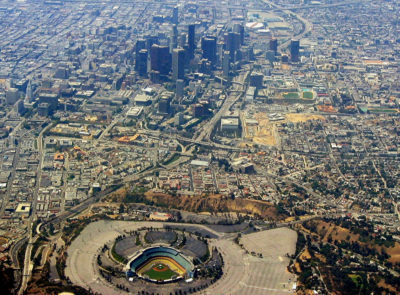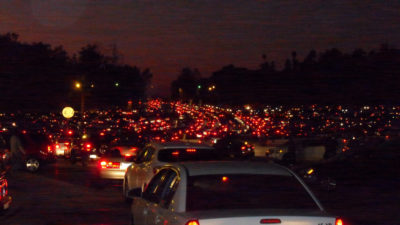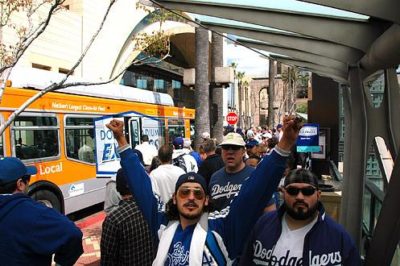Tear Up the Dodger Stadium Parking Lot
It’s not just the Dodgers’ bullpen that needs revision
The Los Angeles Dodgers’ second consecutive World Series flameout has management considering a number of important off-season questions. What is Clayton Kershaw’s future at the club? Will Manny Machado, who reportedly left the stadium after Game 4 wearing a “Villains” backwards cap, get the boot?

Photo by Ron Reiring, Flickr
Here at the Emmett Institute, we have been pondering another question: is there any better use for the massive Dodger Stadium parking lot than storing 16,000 empty vehicles for 2.7 percent of the total time in a year (three hours/game for 80 regular season home games, compared to 8760 hours in a year)?
Los Angeles Mayor Eric Garcetti has made serious commitments to eliminating fossil fuels and pedestrian deaths on city streets. What better place to imagine safe, clean, 21st century transport across Los Angeles than in journeys to our Major League acropolis. Entrepreneurs sparked ideas this year, with the financially incoherent “Dugout Loop” proposal and aerial tramway project capturing headlines. Meanwhile, local thought leaders detailed cheaper options that merit consideration, like cutting a hole in a fence for fans on foot or expanding the LA Metro shuttle service from its current stops in Union Station and the South Bay to other hubs, à la the Hollywood Bowl.
In time, it’s possible Dodger fans brimming with nostalgia will recount inching up the hill to pay for parking. Children will ponder the origins of the glowing orange 76 ball behind centerfield.

There’s another reason to tear up Dodger Stadium’s asphalt.
As Jonathan Zasloff noted in his post last week, when the city of Los Angeles began eminent domain purchases in 1950 to clear a Mexican-American community of more than 1,000 families in Chavez Ravine, it wasn’t to make way for Dodger Stadium but for a 3,600-unit public housing project, Elysian Park Heights, designed by architects Robert E. Alexander and Richard Neutra. The affordable housing proposal was squashed after a fierce political battle toppled Mayor Fletcher Bowron in 1953 amid accusations that spending money on “socialist” housing was un-American. A 1957 City Council ordinance transferred the publicly-owned land to Dodgers owner Walter O’Malley. Sheriffs forced out the last remaining families from the property two years later and the stadium opened in 1962, surrounded by a sea-like surface lot.
The parking is by no means permanent. In 2008, then-owner Frank McCourt released architectural plans including a museum and administrative offices beyond center field. McCourt’s full vision was never realized as a divorce enmeshed franchise finances. In 2012, The Los Angeles Times reported that new owners Guggenheim Baseball Management still pay an entity half-owned by McCourt $14 million a year to rent the parking lots. The 99-year lease includes provisions for future property uses such as homes, offices, shops, entertainment and more. In recent years, Janet Marie Smith, the Dodgers’ senior vice president of planning and development, has led renovations focused mostly on the stadium itself, but the executive also has experience integrating ballparks with cities in Boston and Baltimore. The ownership group includes partners like Stan Kasten, a former president of the Washington Nationals, whose stadium drove growth in D.C.’s Navy Yard neighborhood, and Magic Johnson and Peter Guber, who as co-owners of LAFC, will likely have some involvement in developing Exposition Park’s new master plan.

As Angelenos look to the county’s fringes for new homes, it’s worth considering the available space in our core. There are many ways further development could go wrong, especially if it excludes affordable housing that city residents desperately need and is an important part of Chavez Ravine’s past. Any project plan would do well to include viewpoints of nearby communities that have expressed misgivings about the shape of future land use at the stadium, or even relatives of the displaced Chavez Ravine community, Los Desterrados, who still gather every year in Elysian Park to remember their families’ presence in this corner of the city.
Further reading:
- A history of Chavez Ravine and Dodgers race relations by historian Roberto José Andrade Franco in Deadspin, “The Los Angeles Dodgers Have Not Always Been The Team Of All Of Los Angeles”
- UCLA professor Dana Cuff’s book, The Provisional City: Los Angeles Stories of Architecture and Urbanism
- An extract in The Guardian from Jerald Podair’s book, City of Dreams: Dodger Stadium and the Birth of Modern Los Angeles
- A Mother Jones review of Ry Cooder’s album, Chavez Ravine.
Reader Comments
One Reply to “Tear Up the Dodger Stadium Parking Lot”
Comments are closed.






There is actually a lot of merit to an overhead suspended transport system for passengers in many applications, though perhaps not a suspension cable gondola.
Even light rail is very heavy by the standards of achievable vehicle weight using modern lightweighting technology and a simple back of the envelope estimate suggests that a rigid rail system with catenary support would be a quite cost effective medium speed transport system in general, perhaps even for the north/south high speed rail system, just because of reduced right of way.impact.